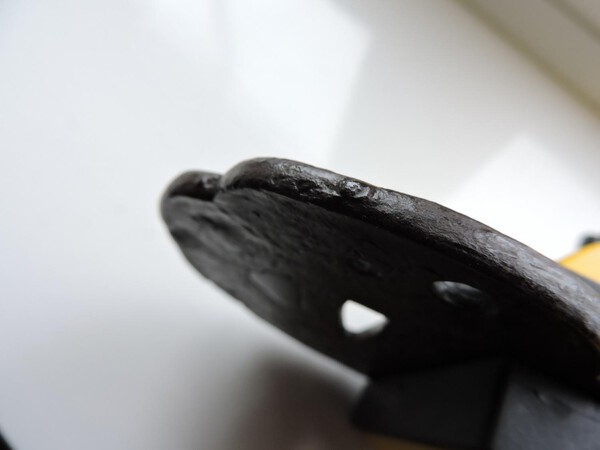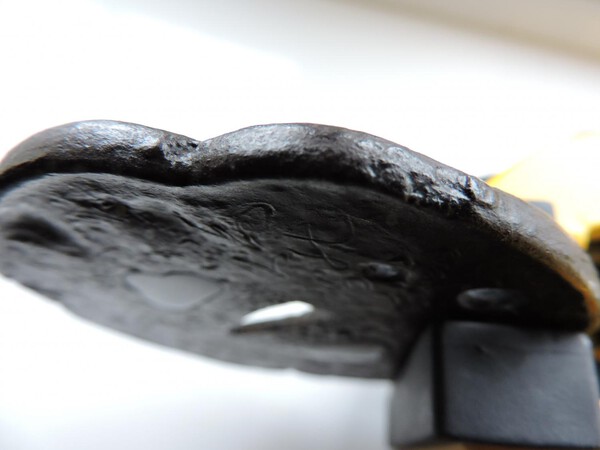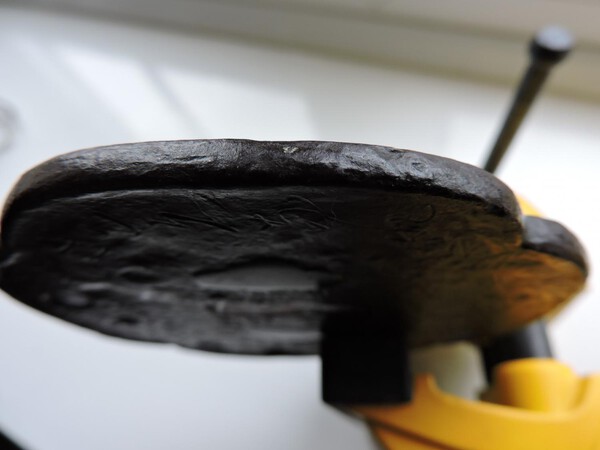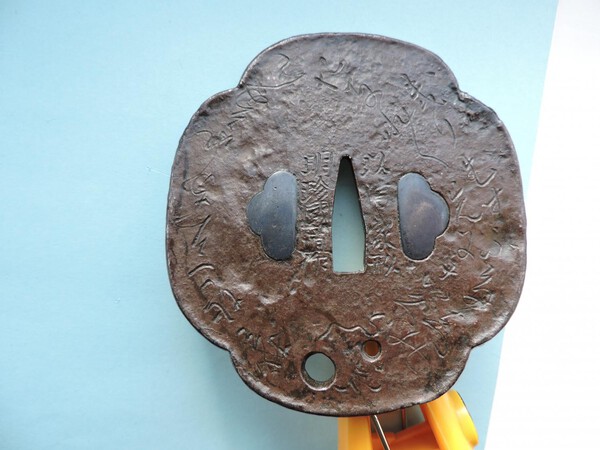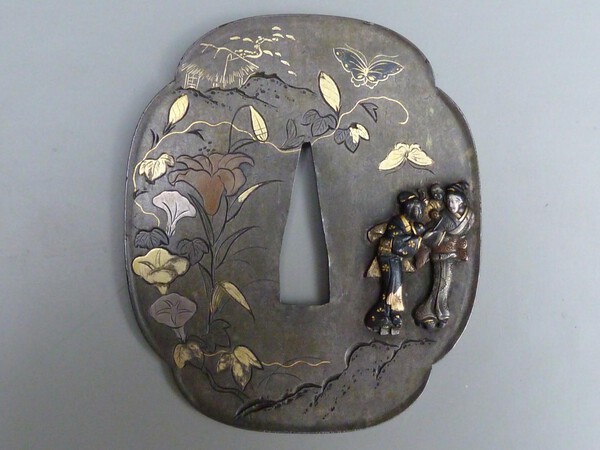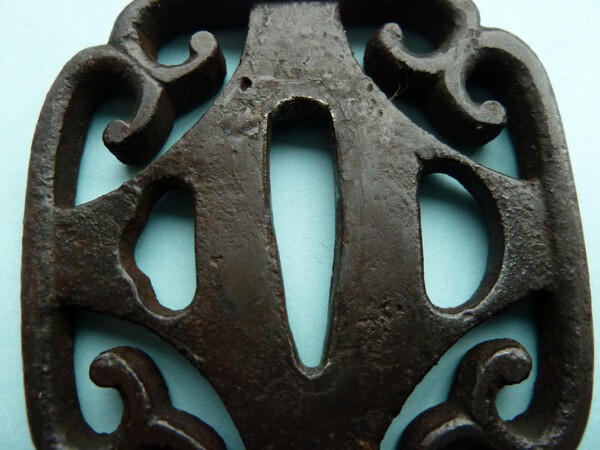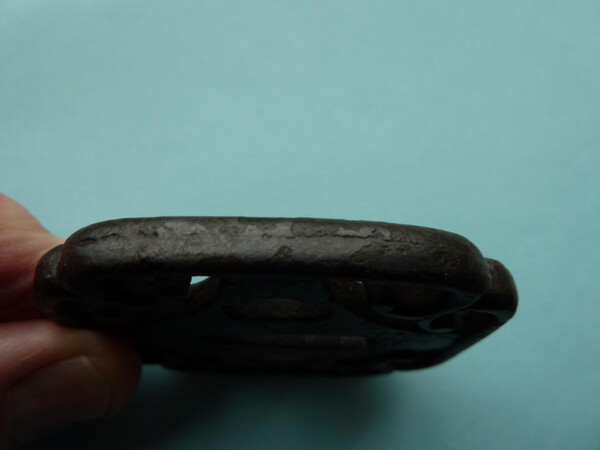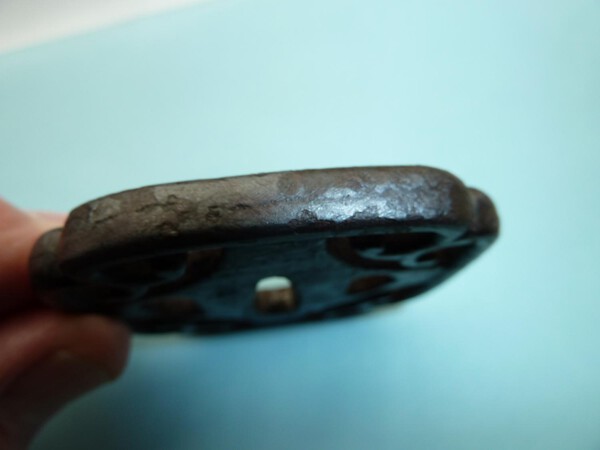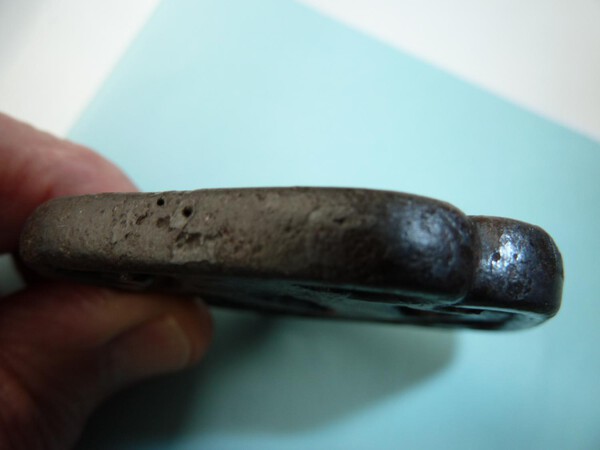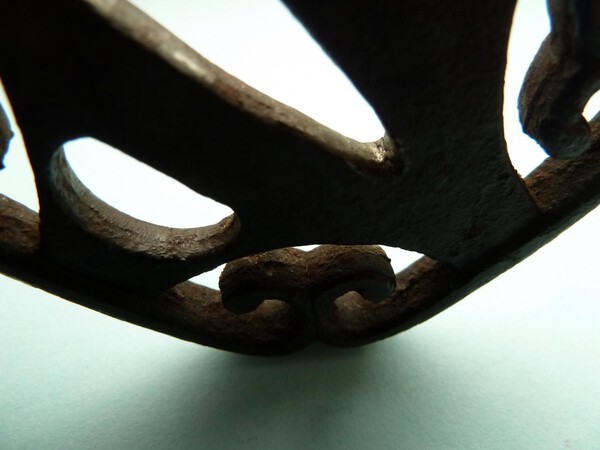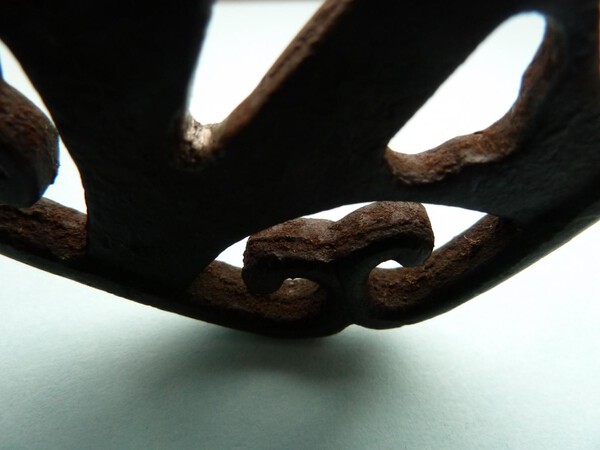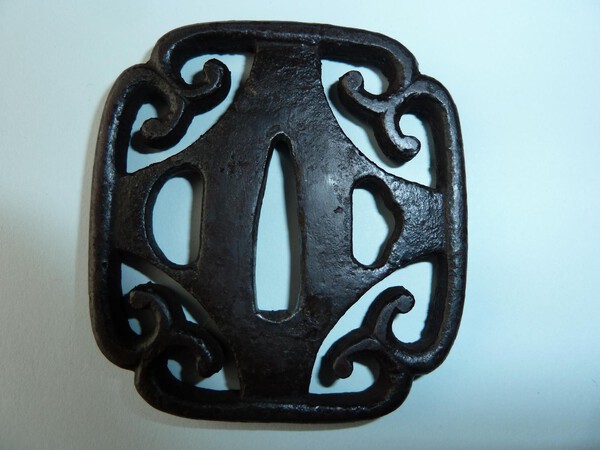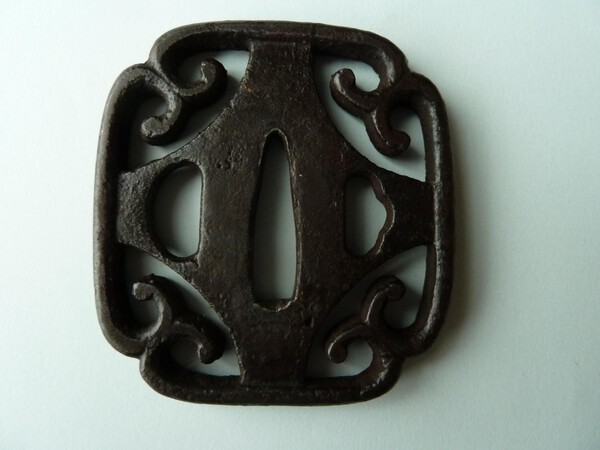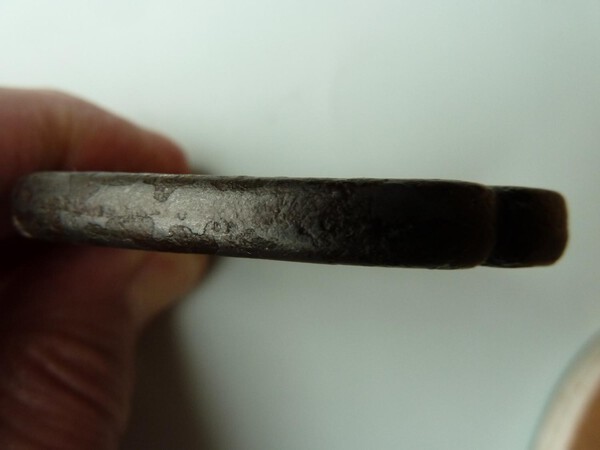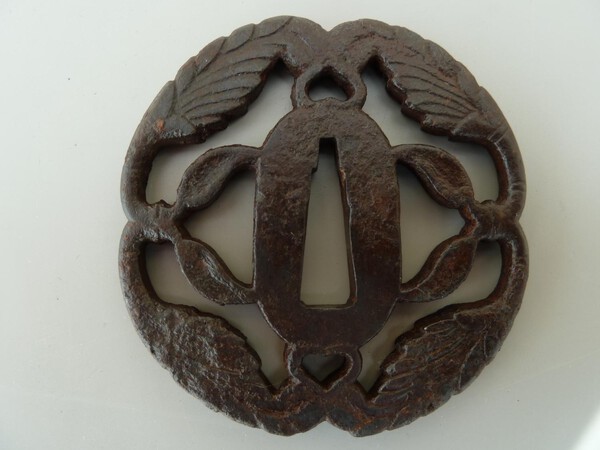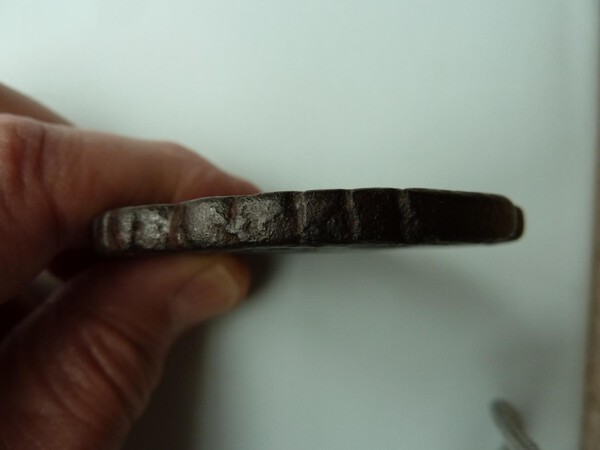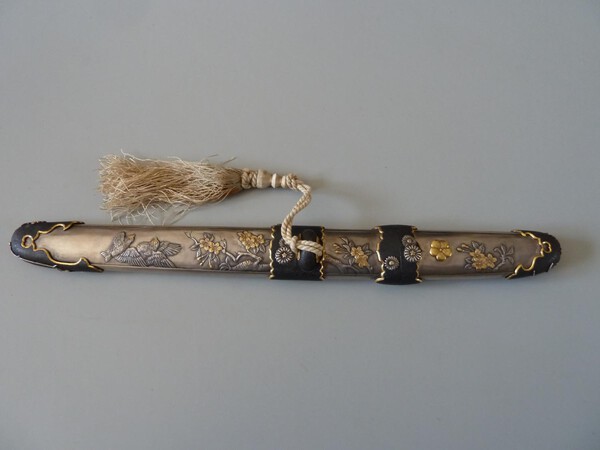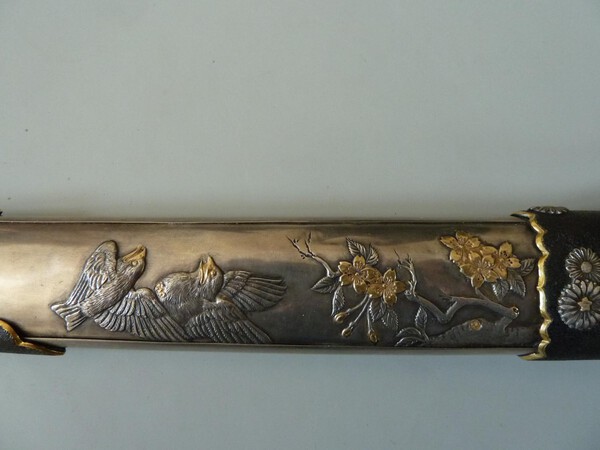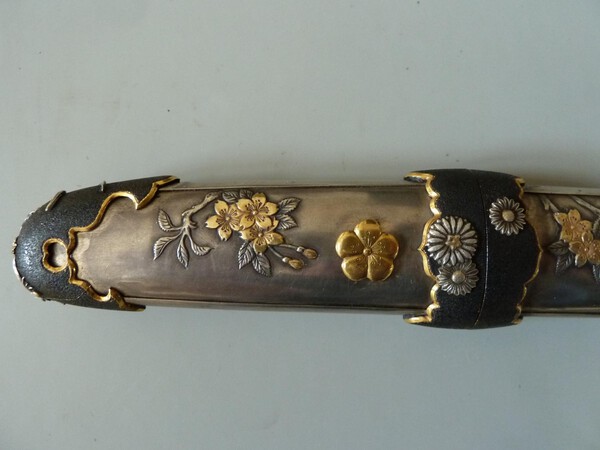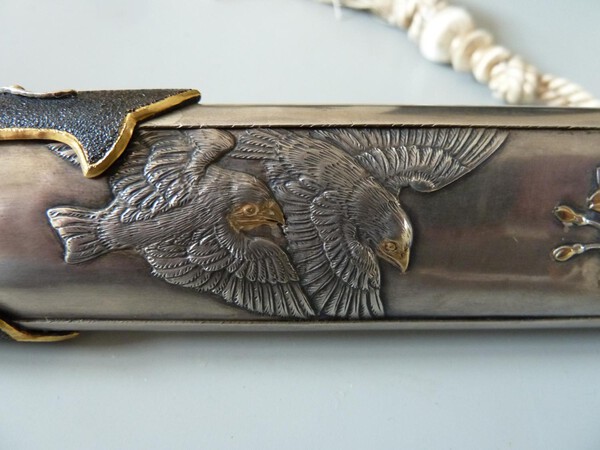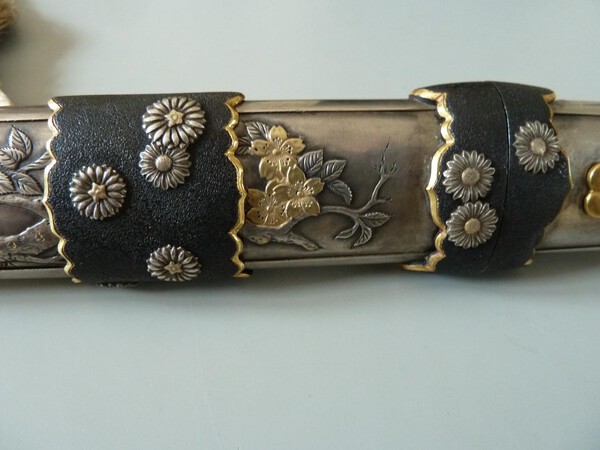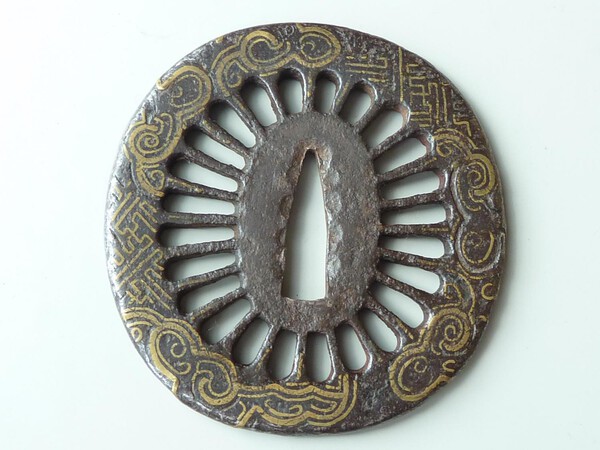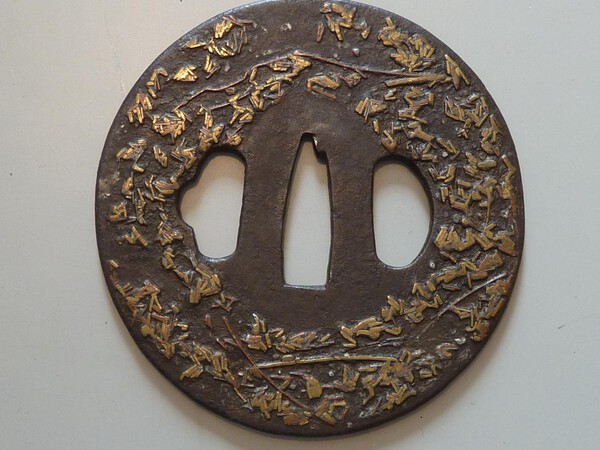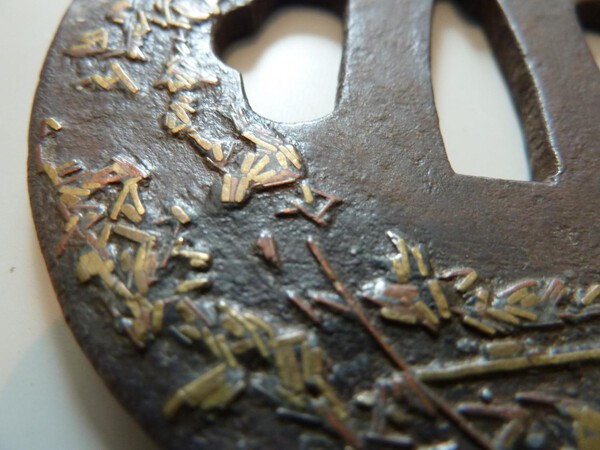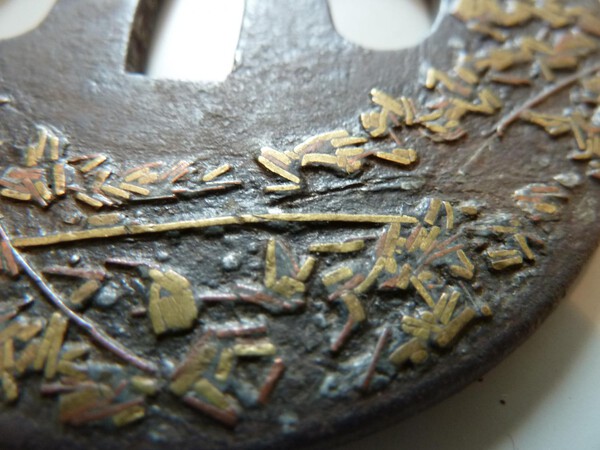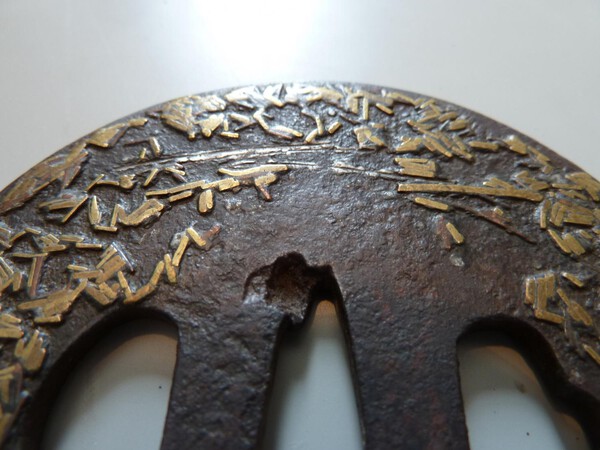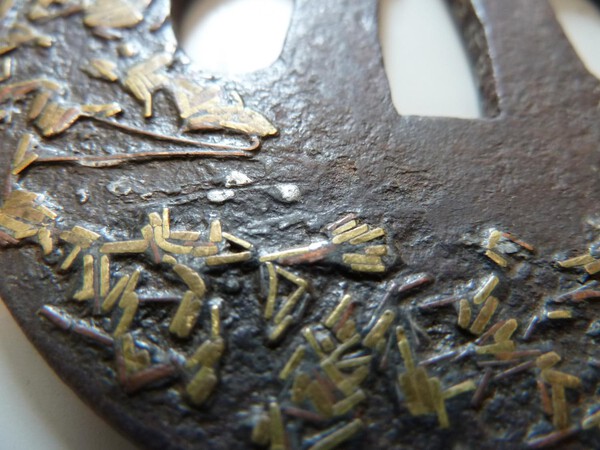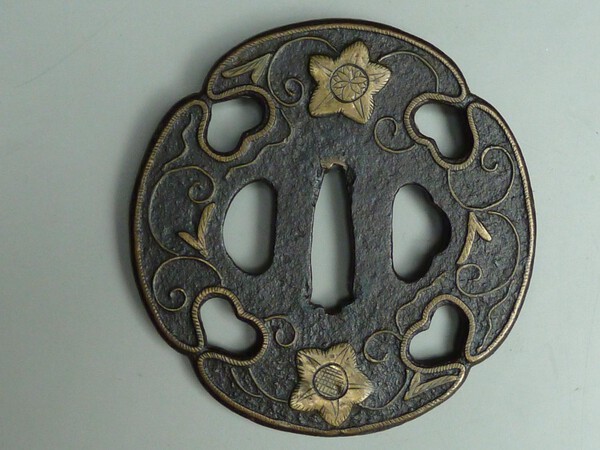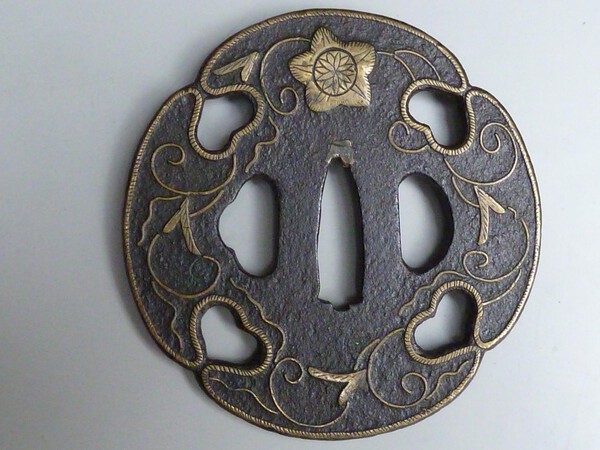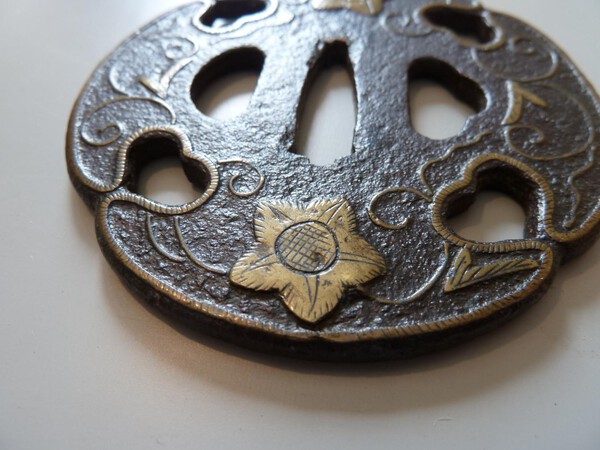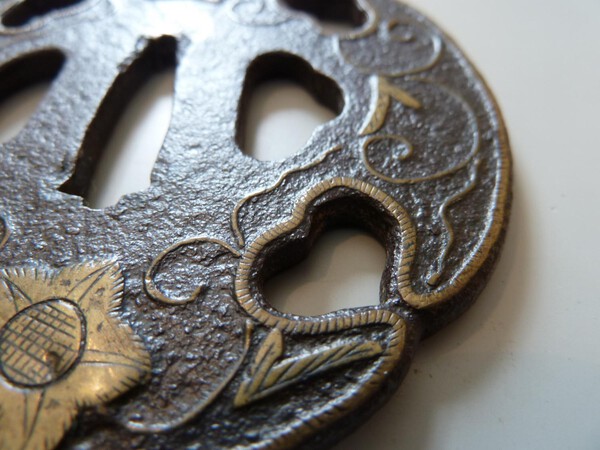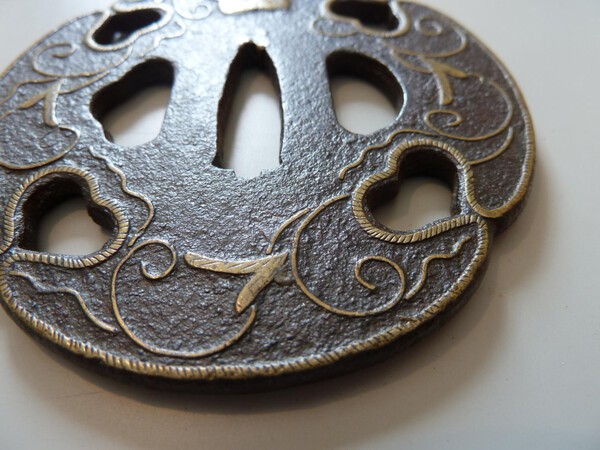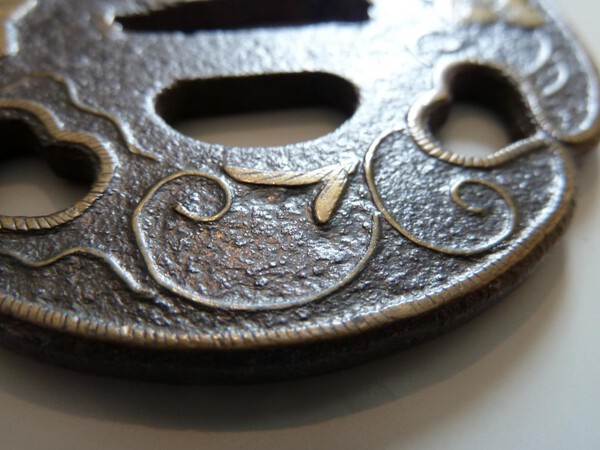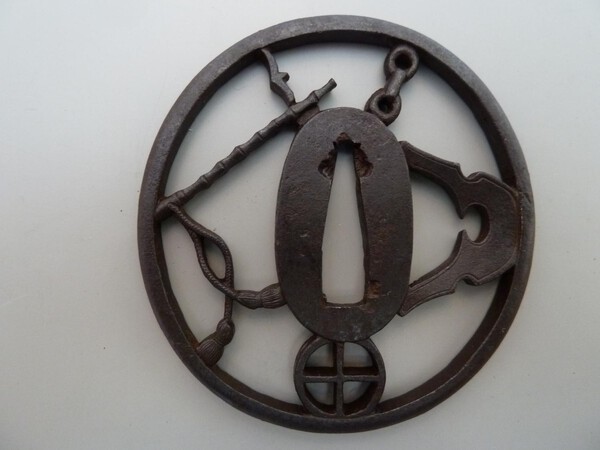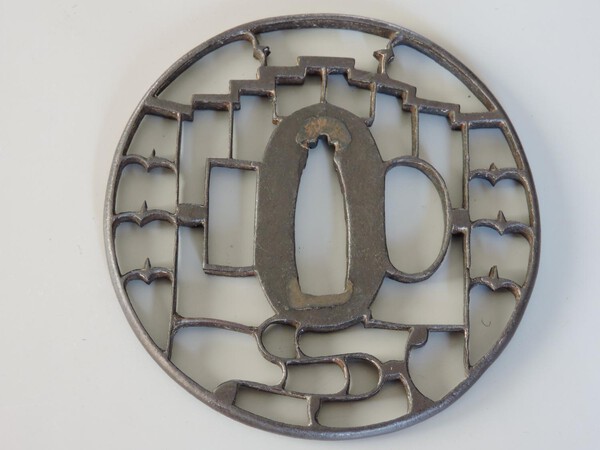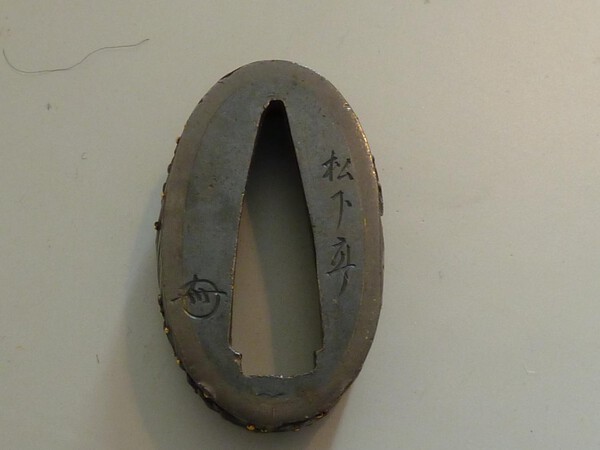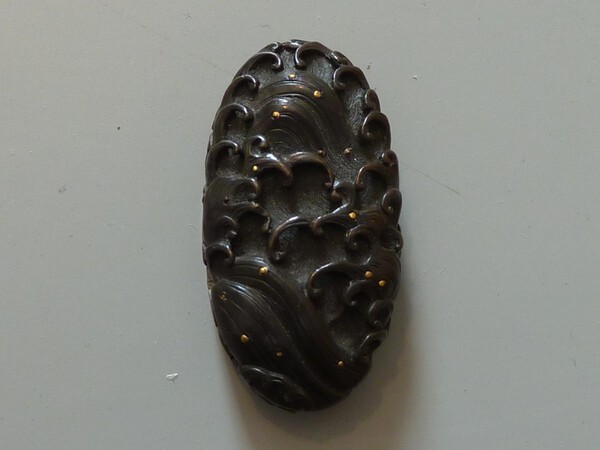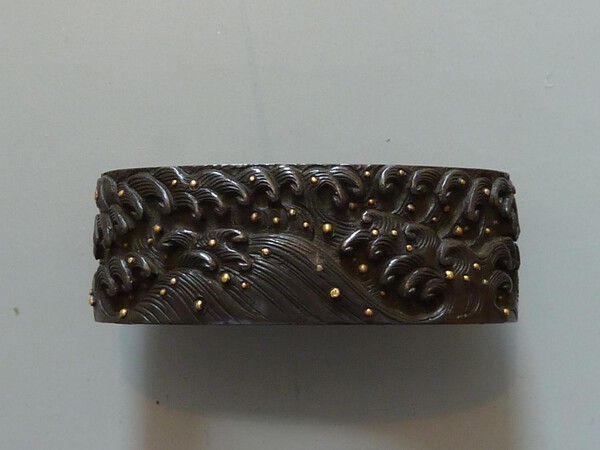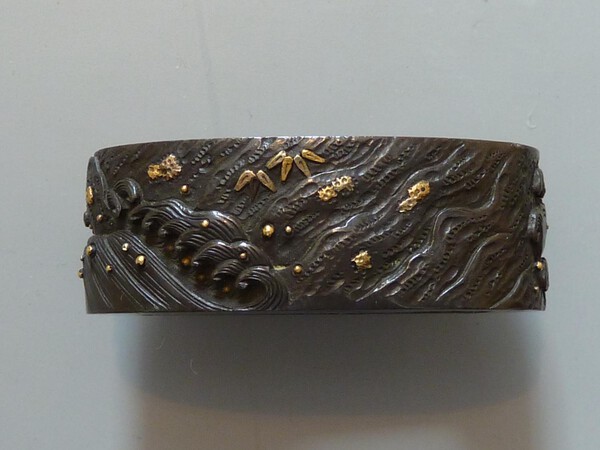
JohnTo
Gold Tier-
Posts
275 -
Joined
-
Last visited
Content Type
Profiles
Forums
Events
Store
Downloads
Gallery
Everything posted by JohnTo
-
Louis, Three very interesting tsuba. I have three that are identical to these, so unless someone is into 3D printing you sold these at Bonhams, November 2017, Lot 73, together with six other assorted tsuba (interesting Kaga Yoshiro that I hope to post soon). It’s a pity that you did not include the boxes, but nonetheless I am happy with the purchase and to be their next guardian. The signatures on the two ‘Nobuie’ tsuba appear to have been made with the same type of chisel as the Momoyama, ca. 1600, Nobuies. There were later generations of Nobuie in the Myochin school, so just because they signed their works is the same way as their illustrious ancestors does not necessarily mean they are fakes, just basing their styles on the ‘greats’ and to promote sales to the gullible. OK, the likelihood is they are deliberate fakes! If you take Japanese signatures at face value then Nobuie, Omori Teruhide, Kano Natsuo etc must have made about 10 items a day, to judge by the number of ‘signed’ kodogu appearing for sale. Also at the auction was a genuine Nobuie (NBTHK Tokubetsu Hozon). This was described as having ‘granular tekkotsu to the rim’. I looked very hard (and I’m short sighted) but could not see anything that I would describe as tekkotsu, it looked like a fine ishime finish to me. I’ve seen coarser bones produced by a cremulator after a cremation. I mention this as the third tsuba that you showed (Myochin Kuninao copy of a Nobuie) has all sorts of lumps and bumps around the rim, see attached photos (sorry about the focus on macro). These are what I would normally identify as tekkotsu (the types vary in shape and size). Are they genuine, or did Kuninao use some other technique to create lumps when copying the Nobuie style? After all lumps and bumps cannot be tekkotsu unless they are made of iron differing in hardness from the bulk material. Thanks Curran for the identification of Kuninao. That’s what I was looking for when I first searched the Notice Board for info on Kuninao. The tsuba is engraved with waka poems. Anyone good at reading calligraphy style hiragana and translating Japanese poems? Regards, John (just a guy making observations, asking questions, trying to learn)
-
Ooops, I forgot the tsuba dimensions: Height: 8.2 cm Width: 7.0 cm Thickness: 0.3 cm at the rim John
-
I thought that I’d post this tsuba for all you soft metal enthusiasts. The tsuba is a mumei, shibuichi plate of mokko form, probably 19th C. The shibuichi is a grey, green silver colour, rather than the brown patina usually seen with shibuichi. Are the two colours of shibuichi a result of different pickling processes and/or a variation in the nominal 25% silver content of the alloy? Perhaps Ford would like to comment. OK, let’s take a closer look at the decoration. The main figures on the lower right hand side of the tsuba are two kimono clad women, one with a baby on her back and the other holding a flower to amuse the child. The figures are executed in gold, copper, silver and shakudo iroe takazogan and are remarkably life like and detailed, e.g. the patterns on their kimono. The next feature is the flowers (probably bell flowers and a lily) depicted in engraved outline and inlaid (honzogan) with copper, silver and gold. The inlay varies from a light wash of material to a complete inlay. The fine engraving in this and other features are precise and evenly cut. At the top left is a thatched cottage in fine gold inlay in a mountain scene. The top right shows two honzogan inlay butterflies, one gold, the other shakudo. Of particular note is the fine gold inlay lines on the shakudo butterfly (1.5 cm wingtip to wingtip) and the ca. 60 minute inlaid gold spots on the wing. I assume that the artist used a needle punch to make the tiny holes and rubbed in a gold mercury amalgam into the holes and then heated the tsuba to drive out the mercury (I believe the technique is called keshikomi zogan). The reverse side of the tsuba is decorated using similar techniques and shows a pair of quail in gold takazogan amongst flowers looking at the moon. Can anyone tell me what the significance of a pair of quail is in Japanese art? I have pairs of quail on the reverse of two other unrelated tsuba. I believe that Mandarin ducks signify wedded fidelity, but quail? To my eyes, the execution of all the items in this tsuba is of the highest quality. In view of the number of techniques involved I wonder if this is a ‘workshop’ piece involving several specialist craftsmen. Any ideas on the school and even the craftsmen? I did see a grey shibuichi tsuba from the Otsuki school with a similar mixture of engraving and inlay in the design amongst the Wrangham Collection (Part IV, Lot30) and that would be my best guess. However I realise that in the 19thC there seems to have been a more fluid interchange of kinko artists and techniques between schools. Now we come to the downside. One of the things I love about pictorial tsuba is identifying the theme of the designs, which are often representations of Japanese or Chinese history or mythology. The components of this design look totally unrelated. I call this tsuba my ‘Sound of Music’ tsuba because it reminds me of the song ‘My Favourite Things’ sung by Julie Andrews in the film. You know the song: Raindrops on roses And whiskers on kittens. Bright copper kettles and warm woollen mittens Brown paper packages tied up with strings These are a few of my favourite things. The reason behind this sobriquet is that I find the subject matter of this tsuba to be a random collection of pleasant images with strong feminine influences. Or to use the current colloquialism, ‘it’s a bit girlie’. Am I missing the big picture and does anyone know the tale depicted here? Looking at pictorial tsuba with human figures in various books and sale catalogues the figures nearly always face the seppa dai, or at the scene on the other side of the tsuba. In this tsuba the ladies are walking away from the hut and the idyllic scene in the background. Is this a symbolic representation of the ladies leaving ‘the Garden of Eden’? Perhaps one of the girls has been sent away from home for having an illegitimate child. I cannot imagine a macho samurai wearing this tsuba. It was probably made for the gaijin tourist market, but there is some staining around the seppa dai, indicating that is was mounted on a sword. Of course it may have been mounted on a garish set of koshirai on a sword put together for tourists, but then sold separately or removed once exported. If it was owned by a Japanese person, I can’t help feeling that it was for someone in the ‘floating world’, possibly a merchant, or a kabuki actor. Comments welcome Happy New Year, regards John (Just a guy making observations, asking questions and trying to learn)
-
Richard has suggested that the brass inlay missing from many/most of the Heianjo/Kaga Yoshiro tsuba might be due to the inlay being deliberately removed to improve the wabi-sabi aesthetics. I believe that the inlay is missing because iron tsuba with brass inlay are intrinsically unstable with respect to galvanic corrosion. Let me explain: The anodic index for some common metals used in inlayed tsuba is as follows; gold: 0.0, silver: -0.15, copper: -0.35, brass:-0.40, iron: -0.85. The higher the difference between two metals, the greater the chance that the one with the highest negative value (anodic) will corrode. Thus gold, silver and copper inlays should cause iron to corrode faster than brass. However, the speed of corrosion also depends upon whether the environment is humid or salty (which will accelerate corrosion due to better electrical conductance). I imagine that brass inlay does not adhere to iron as tightly as the other metals, as it is not so malleable, allowing moisture (rain, sweat) to seep into the brass/iron interface, accelerating the rusting of the iron and loosening the brass inlay. The phenomenon is well known. For example in the 17thC lead sheathing was found to cause the corrosion of iron bolts in ships in the British navy and in 1763 the Admiralty received a report recommending that copper cladding of ships (to prevent barnacle growth) should avoid direct contact of copper with the iron nails used to fasten the cladding, as the nails rapidly corroded. Don’t believe me? Well drop two iron tsuba into salt water. One inlaid with gold, the other with brass. The one inlaid with gold should rust a lot faster. Only joking, but perhaps Ford would like to try a little experiment with inlaid pieces of iron. I think that the heyday of brass inlay in tsuba was about 1600. I wonder if they fell out of favour when the inlay started to fall out after about 50 years? Best regards, John (just a guy making observations, asking questions and trying to learn)
-
Defintely looks forged to me with a uniformly hammered surface. The tsuba looks quite thin, I doubt if iron could be cast as thin as that. See my addition to Sabiji’s post on ‘Hope For More Detailed Information’ for what I think can be seen in a cast tsubaBest regards, John (just a guy making observations, asking questions and trying to learn)
-
Hi Pete, I’ve attached some more pics of one of my tsuba in order to add weight to my claim that it is cast rather than forged. Actually, the conclusion that it is cast was not originally mine. I posted this tsuba on the website some time ago asking for more info, thinking that the line around the rim was evidence of folding and the flaky surface due to high temperature forging. I was surprised that the opinion was that it was cast, but having looked closely, I’m sure that this is the case. I would not have thought that it was financially worthwhile to produce cast iron tsuba. But take a rough cast iron tsuba, finish with a file and chisel, or add a bit of nunome as bling and I suppose you can satisfy the cheap end of the market. So, my case for my tsuba being cast is: Pic 1 #134 The air holes and the tiny raised spots in the surface indicate casting rather than hammer work to me. The seppa dai is rougher than I would normally see, even on an old tosho or sukashi tsuba. Pics 2 & 3 #125, 126. The line running parallel to three rims is due to the join between the two halves of the mould. I originally thought that this was due to folding and incomplete welding of the plate. Pic 4 #123. The fourth rim show casting air holes Pics 5 &6 #130,131. These clearly show a line of protruding iron along the centre of the piercings. I believe this to be due molten iron seeping out of the joins between the two halves of the mould. This is also visible on my other tsuba (the one with ginger leafs posted earlier). My case rests Best regards, John (just a guy making observations, asking questions and trying to learn)
-
Hi, I have a couple of iron tsuba in my collection which I reckon are cast rather than forged iron. They seem to have similar characteristics to your example; namely rounded features, about 6 -6.5 cm diameter, an irregular finish around the seppa dai and are rather thick (0.5 cm), which I imagine made them easier to cast. Though it is difficult to make judgements from photos I think that the common features indicate cast iron. Having said that they are cast rather than forged, I’m not saying that they are (Chinese) fakes, or even modern. I think that they are cheap tsuba made for poor samurai, or more likely for farmers or merchants as they seem to be of wakizashi size. Having cast the tsuba I imagine that they would then be finished by hand with engraving or nunome (your example). Not quite the best tsuba in my collection, but interesting nonetheless. Example 1: Height: 6.3 cm, Width: 6.0 cm,Thickness: 0.5 cm (seppa dai), 0.6 cm (rim) Example 2 (ginger leaves): Height: 6.8 cm, Width: 6.7 cm, Thickness: 0.5 cm Best regards, John (just a guy making observations, asking questions and trying to learn)
-
Hi Ford, Thanks for the science regarding brass. Looks like Heianjo etc brass inlay is younger than many have previously thought. As a retired chemist I love to see science and archaeology getting together. In my own part of the world we have the Amesbury Archer burial. Radiocarbon dates it to about 2,300 BC. Oxygen isotope analysis shows he came from the Alps. The copper of his knife blades came from Spain and the gold of his earings from the somewhere else on the continent. So much info to be gained. Look forward to your book on Japanese metalurgy. Best regards, John
-
Thanks Rich, Steve Looks like I have a Saotome tsuba, decorated at a later date with brass inlay. I get the feeling from your comments and ones concerming the gomoko tsuba (posting Heianjo/Yoshiro tsuba #2) that brass became the 'in' decoration for tsuba in the late 16th C. Perhaps samurai dropped their tsuba into specialist inlay artists while they were in the area during this period if civil war. Much like sailors calling into a port and getting a tattoo.
-
Hi Jerimiah Thanks to all who have posted pictures. Attached are my pics which are of a silver mounted tourist piece. Late 19th/early 20th I would imagine. Not a lot of old interest and qualityabout it, but there is a lot of silver. I shall also post separately a shibuichi tsuba with a silvery patina. Might interest you. regards, John (just a guy making observations, asking questions and trying to learn)
-
OK, a bit of a time delay between posting Heinjo tsuba 1 and 3 and the final one from my collection, but the original photos were a bit naff. Nothing particularly exciting about this oval Heianjo/Kaga Yoshiro type tsuba at first glance, a 24-petalled chrysanthemum (hey, I spelt it correctly!) with brass inlay. I would guess that the inlay the Kaga branch of the Heianjo school. Some of the inlay is missing, which does provide an opportunity to look at how the inlay was applied! Unlike posting for tsuba #1 and #2 the inlay is flush with the iron plate. Of note is the lack of hitsu ana, which may be an indication (not reliable) that this tsuba is pre-Edo, say 1650-1600. An almost identical tsuba came up recently in an auction that I saw on line (see Word document attached) with an NHTBK attribution to the Kaga Yoshiro school. My Japanese is not good enough to make out much more than the mumei Kaga Yoshiro attribution, but I’m happy with their assessment A similar tsuba was sold as part of the Compton Collection (Part II, lot 27, 22 October, 1992). I say similar in that it was also a 24-petalled chrysanthemum (not 23 as Christies counted) with a slight mokko shape and a single kodzuka hitsu. As far as I can see from their photo the punch marks around the nagako ana are similar (round punch along both sides) and it seems the tsuba was attributed to the Saotome school largely because of this kantei point. The inlay was described as a later Kaga addition. I suppose most of us are more familiar with the ca. 72-petalled chrysanthemum pattern that typified Saotome work. My knowledge of tsuba is not good enough to say if this tsuba could be Saotome work, but from the limited information that I have found, Saotome tsuba seem to be thick (4-5 mm) as is this tsuba. I gather that the Japanese liked to embellish old tsuba with soft metal in the Edo period, so a possibility. My inclination is to attribute this tsuba to the late 16th C based upon: The solid nature of the tsuba, which would have been more of a requirement during this waring time. The lack of hitsu ana. The lack of sophistication in both the tsuba and inlay. And finally a silly question. The city of Kyoto was formerly known as Heian. Can anyone tell me why brass inlay tsuba are called Heianjo whereas sukashi tsuba are termed Kyo-sukashi, both being produced in the same area around the same time, ca. 1600? Anyway, comments welcome, so shoot me down. Best regards, John (just a guy making observations, asking questions and trying to learn) Heianjo Tsuba #3 Identical.docx
-
This tsuba appears to be a typical Heianjo gemoku zogan tsuba, popular around the 17th and 18th centuries. As with posting #1, this type of tsuba appears to be attributed to the Kaga Yoshiro offshoot of the Heianjo school. One description that I have seen for this type of tsuba is that they are often old tosho tsuba given a new least of life with this decoration. I’m not sure that this would apply to this particular tsuba as the nagako ana is reasonably ubu with just a single punch mark for fitting a sword. I would expect the nagako ana to be a bit more bashed about if the tsuba had been recycled (unless a later sword was bigger and the nagako ana widened). The iron plate is fairly smooth and may be tsuchime (lighly hammered) rather than polished smooth. I’ve read that the term ‘gemoku’ is derived from the Japanese word ‘gomi’ meaning rubbish or junk and I suppose that is one description of the design, bits of scrap brass wire sprinkled on an iron base and fused/soldered into place. Another description is that the pattern represents a bed of pine needles scattered on the ground or on a lake. I prefer this description, as the ‘rubbish’ has been uniformly cut into about 2-3 mm lengths, some of which are copper. There are also long copper and brass strips resembling twigs. I have seen only one other example of this type of tsuba inlaid with copper as well as brass. This example has both copper and a silver coloured metal inlay (probably a silver solder alloy as it has not turned black), in addition to the brass. Copper and silver inlays are mentioned in the literature, but this is the first time that I have seen an example. How common is this? We then come to the question of how the ‘inlay’ was applied. There are a few fine cuts in the plate where it looks like inlay may have been attached. But they are fine, looking like they had been cut using a Stanley knife (box cutter for our US readers) and don’t look as if they would provide much of an anchor for the long strips of fine copper wire, less than 0.5 mm in diameter (obviously they did not provide a firm anchor in some cases, as the inlay is missing!) The close up photo shows groups of pine needle inlay raised slightly above the iron plate, imbedded in a matrix, which I assume to be some type of silver solder. These are therefore not true inlay. Other, single needles and fine copper twigs (less than 0.5 mm diameter) show no outward sign of solder. Has this been carefully trimmed away? There are a couple of long cuts where it looks like the ‘twig’ inlay did not attach, but are surrounded by silver solder. Why did the tsubako leave solder around these cuts, but not round the ‘twigs’ that were attached? Soldering these fine bits of ‘rubbish’ onto the plate must have presented the artisan with some problems. Presumably they did not have access to some kind of blow torch for local heating. Possibly groups of needles were placed on a thin sheet of solder and attached in one go by heating the whole tsuba. But this does not seem to have been done for individual needles and twigs. Having completed one side, perhaps they placed the tsuba upside down on an iron plate to prevent the soldered bits falling off when the other side was decorated! I must admit that until I bought this tsuba I was not very taken with gemoku decoration, considering it to be ‘rubbish’. However, looking closely at the way that the fine ‘scraps of brass and copper rubbish’ have been attached, they could not have been that easy to produce. Dimension: Height: 7.6 cm, Width: 7.4 cm, Thickness: 0.35 cm Old collector’s number ‘252’ inside the nagako ana (What a pity that the old inventories of these collectors do not seem to be extant as reference pieces). Best regards, John (just a guy making observations, asking questions and trying to learn)
-
Up until recently I have never seen the attraction in brass inlayed tsuba typified by the Onin, Heianjo, Yoshiro and Jingo schools, to my mind, gold is a much classier metal for inlay. However, I saw one at auction recently and decided to buy it as it was in great condition; only one section of about 1 cm of fine inlay was missing. I have attributed the tsuba to the Kaga Yoshiro school, as several other very similar examples attributed to this school appear in books (Peabody Museum E31250) or are currently for sale (e.g RiceCracker.com). The combination of bell flowers (with five petals) and asymmetric ‘V’ shaped leaves on the vine seem characteristic of this off-shoot of the Heianjo school. After studying the tsuba for a while I have begun to appreciate its charm. It has also raised a few questions regarding the iron base plate of the tsuba. In most of the examples of Heianjo/Yoshiro brass inlay tsuba I have come across, admittedly mainly in books or through a glass cabinet at a museum, the inlay looks fairly flush with the smooth iron plate, or the plate is described as ‘lightly hammered’ if it is not perfectly smooth. The plate on this one has a granular appearance, as if etched with acid (see photos). The tsuba looks as if has had brass inlay applied to a flat iron plate, the brass masked with a protective coating and immersed in acid to remove about 0.5mm of iron, but maybe the whole plate has this texture and was etched before the inlay was applied. I’m surmising that the granular appearance is due to a mixture of different steels in the plate dissolving at different rates. To support this assumption I remember as a kid dropping a copper penny into nitric acid and watching it dissolve. The penny just got thinner and thinner, but the embossed design remained visible, the dissolution process occurring at the same rate over the homogeneous metal. I would expect that ‘lightly hammering’ the plate would produce smooth indentations, not the granular appearance seen on this tsuba. Perhaps this tsuba had become heavily rusted and has been restored, but I don’t think so, the surface is too even, whereas rusting would mostly likely be confined to specific areas. So, first questions, do others out there think that the tsuba has been acid etched and how common was this procedure? The granular appearance raises another question. The parts that stick up from the surface areas are probably harder steel/iron and so can they be considered as tekkotsu (iron bones)? OK, I agree that they are not the classic tekkotsu that I have seen on the rims of tsuba arising from the forging process, but….. The final question that I have regarding this tsuba is the patina. There is no rust on this tsuba and the shine on the patina of the iron looks as if it has been waxed, coated with lacquer in historical times, or polyurethane in recent times (Ugh!). This type of tsuba was popular around 1600 but looks as if could have been made yesterday, but I hope not. It has either been treasured over the centuries, or may be a later copy of this popular design. Apart from the gloss on the iron there is no other sign of a coating, e.g. worn areas, edges to the coating. Two other iron tsuba from the same auction lot have normal patina, so I can’t attribute the gloss to the previous owner. Any thoughts? Dimensions: Height: 7.7 cm, Width: 7.5 cm, Thickness: 0.4 cm Best regards, John (just a guy making observations, asking questions and trying to learn)
-
Hi Luca, I too have acquire three Heianjo/Toshiro tsuba recently and find then impossible to date accurately. Around 1600 is about as good as it gets for me as Japanese craftsmen often slavishly copied their masters for generations, if a particular item sold well. Then, of course, if a particular school gained interest amongst collectors, they were copied. Over the next few days I will be posting notes and questions about my three tsuba, which I hope will be of interest. Best regards, John
-
'If a man does not keep pace with his companions, perhaps it is because he hears a different drummer. Let him step to the music he hears, however measured or far away.' David Thoreau. 'Go your own way.' Fleetwood Mac Remember if we only colected 'old iron' the rest of the tsuba world would be worthless. Collect that which gives you most pleasure (and is affordable) regards, John
-
Hi Dude, Thanks for your reply. If you look at my original posting it stated that ‘My tsuba is more refined than the Tadatora one (Note that I do not say better, depends upon your ascetics) in that the mantis has more of a three dimensional body on both sides and the legs and the antennae are more finely carved, like kyo-sukashi work. ‘ I considered putting ‘I DO NOT SAY BETTER’ in capitals, and no doubt should have. By refined I mean the representation is more lifelike and detailed. Much in the same way as a Rembrandt could be considered as more refined than a Picasso. In the old sukashi tsuba, typified by Sasano’s book, the quality and forging of the iron is paramount. In later sukashi tsuba (like this one), emphasis seems to have switched to a more detailed carving of the design, plus embellishments with gold nunome highlights. I would not be surprised the tsuba makers at this time just started with sheets of industrial grade(nambam testsu) iron as it usually looks homogeneous. I have a couple of cast iron tsuba (bought cheaply I hasten to add) and the iron looks totally different, so I don’t think that it was cast Best regards, John
-
The second 19thC sukashi tsuba shows a praying mantis and a wheel, a fairly common subject for tsuba design. I bought this tsuba as part of a job lot at a recent auction. When I saw the image in the auction catalogue I knew that I had to go for it. The other six were worth having too, but I fell in love with this one. I think there is a ‘Mantis Dude’ out there who might like this tsuba as well. The story behind the design of a mantis and wheel is probably well known to most of you, but worth repeating. One version concerns the ‘King of Qi’ who, while in a procession, noticed a mantis standing up defiantly on the road in front of one of his carriage wheels. Upon being told what the insect was the King is supposed to have said ‘What a pity that it is just and insect. If it were a man it would be the bravest warrior in the world.’ The king then ordered his carriage to carefully go around the mantis without crushing it. The story is also related in a different form as a quote by the Chinese Taoist philosopher Chuang Tzu (Zhuangzi) who said ‘Don’t you know about the praying mantis that waved its arms defiantly in front of an approaching carriage, unaware that its arms were incapable of stopping it? Such was the high opinion it had of its talents.’ The mantis is often represented in Asian art for its bravery, however the inclusion of the wheel in this tsuba is a reminder that no matter how brave, one should be aware of ones limitations and act accordingly. I do wonder if this warning is aimed at the wearer of the sword bearing this tsuba, or to a potential adversary. An earlier (ca 1700) version of this tsuba is shown in Sasano’s sukashi tsuba books (#208 or #232 depending upon the version) and is attributed to the third generation Akasaka master , Tadatora. The Tadatora tsuba is, as far as I can see from the photos, a two dimensional representation (i.e. flat) except for one of the eyes of the mantis. Another, more abstract version, of this design was sold as part of the Compton Collection (Christies, Part II, Lot 71) and attributed to the Akao, Echizen school. Yet another version in Shakudo with gilt details was sold at Bonhams (6 November 2012 Lot 207, I was the underbidder on this lot. Damn!). Apparently Dick Tait posted a question here in 2013 about a similar tsuba. Unfortunately, I can’t download his pictures, due to some format problems I guess. My tsuba is more refined than the Tadatora one (Note that I do not say better, depends upon your ascetics) in that the mantis has more of a three dimensional body on both sides and the legs and the antennae are more finely carved, like kyo-sukashi work. The masterful stroke in the design of my tsuba is the portrayal of the eyes of the mantis in gold. Presently the tsuba sits on a shelf facing me as I sit and as evening approaches the dark iron fades from view, leaving just the two gold eyes staring defiantly out at me. Spooky! An exact copy of this tsuba (essentially same dimensions) can be found in the collection of the New York Metropolitan Museum of Fine Art, the only difference being the presence of punch marks around the seppa dai in the Met’s example (accession number 46.122.109), purchased in 1946. I think that they are almost certainly made be the same hand. Unfortunately the only information that they give, on-line, is 19C tsuba. So we come to the usual crunch question: School and maker please. The second question is whether my or the Met’s tsuba is a fake/copy as there are a lot of copies of sukashi tsuba appearing on the market? I think that both are genuine because: The Met’s example was purchased in 1946, making it unlikely to have been used as a template. My example was purchased as part of a job lot of 7 varied tsuba, which looked to be part of an old collection. I would expect the artist to have made several copies of a design that sold well. The presence of tiny lumps and bumps (tekotsu or corrosion) make it unlikely that mine was machine made, despite the exactness of the carving. I don’t want mine to be a fake and even if it was, I’d still love it! Dimensions: Height: 7.4 cm, Width: 7.0 cm, Thickness: 0.4 cm . I’m happy to date this tsuba to the mid 19thC. The fine carving of the legs and antennae of the mantis seem to shout; Kyo-sukashi, as does the D-shaped rim. Akasaka (in view of the earlier Tadatora version) is an obvious assignment, or possibly Owari or Shoami. Opinions please. Regards, John (Just a guy making observations and hopefully learning by asking questions) NYMMFA Mantis Tsuba.docx
-
I thought that I would share my observations of these two 19thC iron tsuba as they share a lot in common and possibly typify the way that sukashi tsuba were developing at this time (comments?). The other tsuba is posted separately (Sukashi Tsuba #2: Mantis and Wheel). Both tsuba are essentially circular (7-7.5 cm diameter) with a D-shaped profile to the outer rim. Both seem to have been cut from a flat plate with simple, largely open sukashi designs, parts of which have been carved below the plate surface to produce three-dimensional effects. The design of the first tsuba based upon three pieces of horse riding equipment, namely a saddle, crop and bit, plus a single bird linking the crop to the rim. First Questions: The use of birds to link and strengthen different parts of sukashi tsuba is common, even though it often appears to have nothing to do with the overall design. Why not use straight bits, circles or S-shapes? Any reason why a simplified bird is used? I’ve sometimes seen them called chidori (sparrows) and sometimes geese, but they look generic to me. Is the use more prevalent amongst certain schools? When I first got this tsuba I thought that the cross within a circle was the Shimadzu family crest, or perhaps some Christian symbolism. I realised that in fact it is one side of a bit used in a horse’s mouth, the middle part (the chain link) appears at the top of the tsuba and the other side is missing from the design. Perhaps the separation of the parts of the bit is deliberate and is in fact a secret way of alluding to Christian leanings of the owner. One of the features that I like about this tsuba is the difference in sukashi carving. The cross within a circle is a simple two dimensional design, i.e. flat across the face. The crop and chain are more rounded and the change to a three dimensional design is completed with the saddle, which is skilfully shaped. To my mind, this makes the design more interesting than the essentially flat (two dimensional) designs commonly found on Kyo and Akasaka works. The tsuba is signed Hidemitsu (possibly read as Shumitsu) but I can’t find a Hidemitsu in Markus Sesko’s genealogy charts or elsewhere. So, Question 2: Any information regarding the artist or school? The tsuba is oval (7.4 cm high by 7.0 cm and 0.5cm thick) with a D-shaped rim, the outer edge being rounded. Overall the tsuba is in good condition with small areas of red surface rust on an otherwise dark, purplish black patina. The rim is essentially smooth with some small (1 mm) lumps which may be due to tekotsu rather than corrosion. Based on the carving within the rim I’d go for Bushu, Higo, Shoami or possibly Kinai schools, all of which seem to have produced open sukashi tsuba with carved designs. But then I wonder if travel within 19thC Japan was so commonplace that tsuba artist were pretty fluid as to where and for whom they worked, so that schools lost much of their identities. I’ve seen several riding equipment tsuba at auctions over the years and have added this Owari tsuba from the Boston Museum of Fine Arts, which shows some similarities in the design but the forging appears totally different (Word document). Regards, John (Just a guy making observations and hopefully learning by asking questions) OWARI TSUBA FROM BOSTON MUSEUM.docx
-
- 1
-

-
Thanks Jim for your version of narihira's departure from Kyoto poem. Michin Curran. Ive seen Jim Gilbert's Kyo sukashi tsuba on the link on this website. The two tsuba are essentially identical but in mine the birds are flying upwards, in Jim's they are flying downwards. Its impossible to tell if they were made by the same guy, but I like to think so and that one morning he thought 'I'm bored. Kow what, today I will make the birds will fly the other way' john
-
Thanks guys for putting me straight regarding the lost wax moulding process vs the actual way menuki are made. I'm not a pratical metal worker, just someone who observes and makes comments on their observations. Menuki don't have a particular interest to me, I much prefer tsuba. When I ran a science group I would often say (when I was wrong) 'A c$%p theory is better than no theory at all' regards, John
-
Thanks Steve for the information. I’m familiar with Ariwara no Narihira (825-880) composing a poem at the 8-plank bridge (yatsuhashi) at the iris marshes of Mikawa at the time of his banishment from Kyoto I have a Kyo sukashi tsuba from the Goodman collection depicting this incident (described in the catalogue as banners flying in the wind), which I love very much (see Pics). There are lots of different versions of this tsuba, some just the bridge (my version), some just the irises, some with both. I guess that is what I love about tsuba, being able to find out what the theme is, especially when it is wrongly catalogued at auction. I have not been able to find the definitive poem that Ariwara no Narihira composed at the bridge that expressed his wish to return someday to Kyoto. One quoted example was: 殻衣きつつなれにしつましあればはるばるきぬるたぼをしぞ思ふ。 Karakoromo kitsutsu narenishitsumashi arebaharubaru kinurutabi oshizo omofu. A Chinese robe I have worn so often, I know it as I do my wife. Having come so far, this journey rests heavy on my thoughts. Reading that his banishment had something to do with his numerous dalliances with the ladies of the court I find it hard to believe that he should write a poem about his wife, or is he just missing his Chinese robe? Regards, John
-
I hope you have not maligned the Aoi, they may both be genuine and have been made by the lost wax process, which has been used since the bronze age. I recently went to the V&A museum in London where they had a video showing the casting of a complex bronze figure using this process. I have no knowledge of how Japanese tosogu artisans worked, but the process was common in China. So here goes my description of the possible process of making a simple shaped menuki. First step is to get hold of a suitable modelling material. Clay or wax is often used in the west, but ivory offcuts from the netsuke makers would be ideal. Glue the ivory to a metal or ceramic plate and carve out the face side of the menuki. Cover the finished carving with a releasing agent and pour on plaster of Paris to make a mould. Slip a knife under the metal/ceramic plate to free the mould. Pour a small amount of wax into the mould and swill round until the inside surface of the mould is coated. Repeat until the wax layer is of the correct thickness. A bit like making a chocolate Easter egg. Place small pieces of wood (matchsticks) at either end of the open side of the mould. Press any metal grips sometimes found on the inside of menuki into the wax. Fill the open mould with more plaster of Paris to make a single lump with the bits of wood sticking out. Once dry, remove the bits of wood, place the completed mould upright and heat until all the wax has run out. Pour in the molten metal of choice then smash the mould to free the menuki. Cut off the metal from the casting hole and finish of the menuki as desired (guilding, engraving, inlay, etc). The making of plaster of Paris moulds can then be repeated many times. Of course, if the original carving becomes damaged the flaws will show up in all subsequent moulds and subsequent castings. I ask the question ‘Why would a menuki maker not use this simple method for an object which has no complex undercutting?’ These guys had to make a living. Although they may have used the same mould they could probably vary the metals used as well as the finishes. The original carving would have been thrown away once it had started to deteriorate. In my opinion, the average tosogu was not in the habit of making one-offs. I have an iron sukashi tsuba which is an exact duplicate of one the NY Met. As theirs was bought in 1946, I doubt if mine is a later forgery, just a second example of a successful design used by the maker (I’ll probably post it later). Most bronze artists make multiple castings of their sculptures then destroy the original clay model. Did you know that there about 28 bronze castings of Rodin’s ‘The Thinker’ not considered fakes. Best regards, John
-
You can heat the tsuba in a steam of dry hydrogen. A heavily rusted viking sword was treated this way to reveal fine brass inlay (like a Heianjo tsuba). Not a prcoess for the amateur collector though. regards, John Corrosion and metal artifacts - a dialogue between ... - NIST Page nvlpubs.nist.gov/nistpubs/Legacy/SP/nbsspecialpublication479.pdf CONSERVATION OF RUSTY IRON OBJECTS BY HYDROGEN REDUCTION. L. Barkman. 155 ...... Figure 4a. Hilt of a viking sword before hydrogen reduction ...
-
Unfortunately fakes abound in all areas of art. Once a certain object passes a price threshold the fakers move in, as they have for a 1000 years (Stowe school Yasutsuna tachi, Chinese ceramics). In our field of Japanese swords and tosugu the signatures of many famous artisans are doubful. Omori Teruhide, and Kano Natsuo must have been producing about 10 tsuba a day, if you go by signatures. With modern equipment and the limited knowledge that we collectors have with authentic pieces (how many of us have more than 10 good pieces in our collections?), the problem will get worse. Thanks for the reminder and warning. John
-
Can anyone help regarding the signature maker of this Omori style fuchi/kashira? I bought this at a London auction back in 1975 and the signature was listed as Matsushitatei. As the signature is in a flowing script I have had trouble confirming this. I’m OK with the kanji for Matsu and Shita, but I have never found anything looking like the third kanji for Tei in any reference book. The design of the fuchi/kashira is the classic Omori waves in shibuichi with highlights picked out in gold. It is very similar to a larger example sold in the RB Caldwell collection, Sotheby’s 30 March, 1994, Lot 327 and signed Omori Teruhide. I thus conclude that my fuchi/kashira was copied from a Teruhide design and must be one of the few copies of this type of work not actually inscribed ‘Teruhide’. Matsushitatei, or a name like this, does not appear in the Omori school genealogy chart (Genealogies of Japanese tsuba and toso-kinko artists, Markus Sesko). Of course Japanese artisans often changed their names several times in their careers, so he may be listed under a different name. The only reference I can find to Matsushitatei is a mumei menuki with NBTHK Hozon paper attributing the work to ‘Goto Kenjyo (1586-1663), Matsushitatei school’. However, his dates would probably be too early for this design (Omori Teruhide’s dates are 1730-1798). Besides, there appears to be no link between the Goto school and this mysterious Matsushitatei school. Can anyone provide information about this not-readily documented artist or school? Best regards, John

